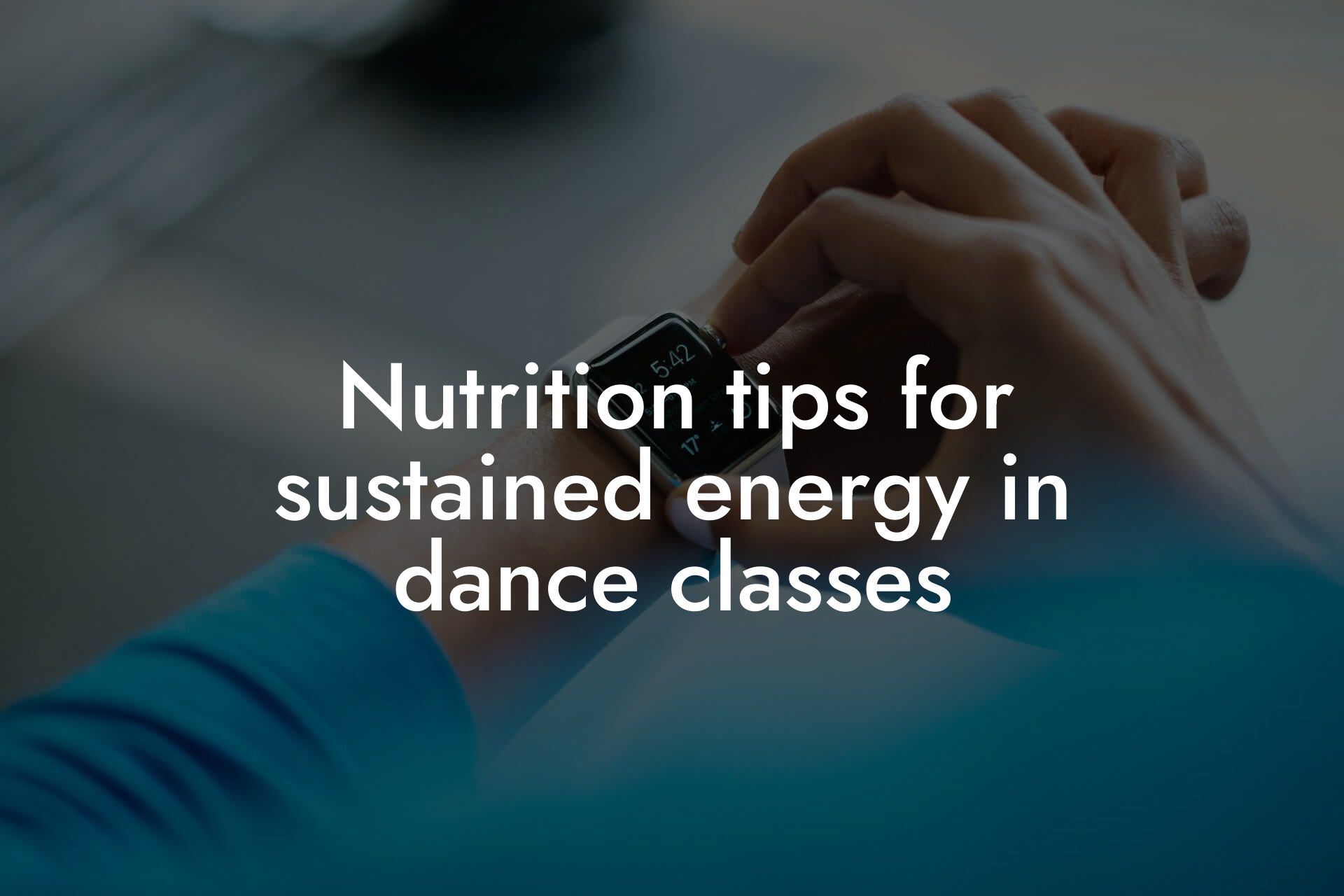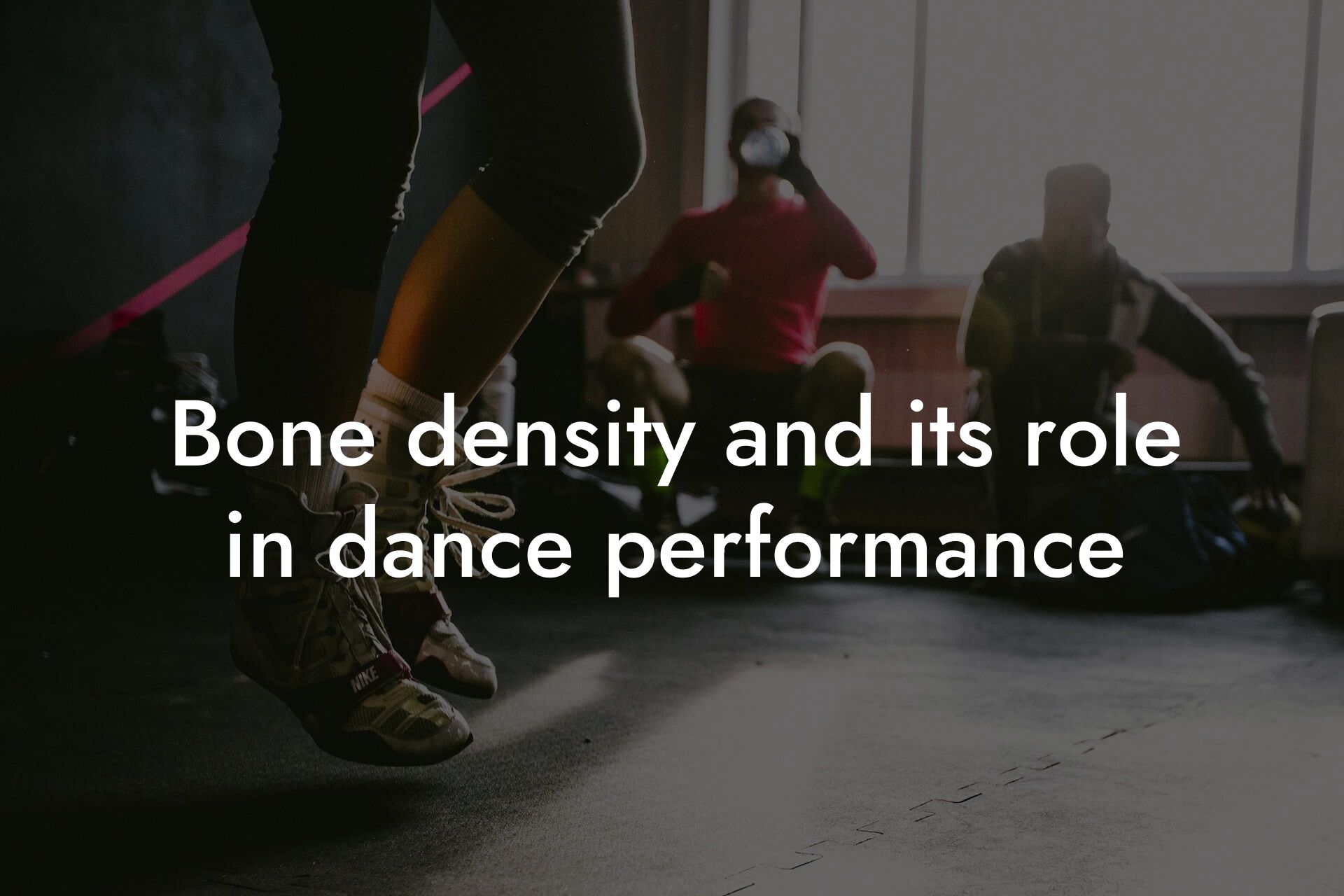As a dancer, you know that intense sessions can take a toll on your body. Prolonged periods of physical exertion can lead to fatigue, muscle soreness, and decreased performance. However, with the right recovery techniques, you can minimize the negative effects of intense dancing and get back to your best in no time. In this article, we'll explore the importance of recovery for dancers and provide you with a comprehensive guide on how to recover effectively after intense sessions.
Table of Contents
Why Recovery is Crucial for Dancers
Recovery is an essential component of any dancer's training regimen. When you dance, you're not only burning calories and building endurance, but you're also causing micro-tears in your muscles. If you don't give your body time to repair and rebuild, you may experience a range of negative effects, including:
- Decreased performance and flexibility
- Increased risk of injury
- Prolonged muscle soreness and fatigue
- Impaired mental focus and concentration
Understanding the Different Types of Recovery
There are several types of recovery, each with its own unique benefits and applications. The three main types of recovery are:
- Passive recovery: This type of recovery involves complete rest and relaxation, with no physical activity whatsoever.
- Active recovery: This type of recovery involves low-intensity physical activity, such as stretching or light cardio, to promote blood flow and relaxation.
- Functional recovery: This type of recovery involves specific exercises and techniques designed to target specific muscle groups and improve functional movement patterns.
Immediate Post-Dance Recovery Techniques
After an intense dance session, it's essential to prioritize immediate recovery techniques to minimize muscle soreness and promote relaxation. Some effective techniques include:
- Static stretching: Focus on static stretches that target your major muscle groups, including your hamstrings, quadriceps, and hip flexors.
- Foam rolling: Use a foam roller to roll out your muscles, focusing on areas that feel tight or sore.
- Self-myofascial release: Use tools like lacrosse balls or tennis balls to release tension in your muscles and connective tissue.
- Hydration and nutrition: Replenish lost fluids and electrolytes with a balanced meal or snack that includes protein, complex carbohydrates, and healthy fats.
Long-Term Recovery Techniques
In addition to immediate post-dance recovery techniques, it's essential to incorporate long-term recovery strategies into your training regimen. Some effective techniques include:
- Regular massage therapy: Schedule regular massages to promote relaxation, reduce muscle tension, and improve circulation.
- Active isolated stretching: Incorporate active isolated stretching exercises into your routine to improve flexibility and range of motion.
- Strength training: Incorporate strength training exercises into your routine to improve muscle imbalances and reduce the risk of injury.
- Rest and relaxation: Prioritize rest and relaxation, aiming for 7-9 hours of sleep per night and taking regular breaks throughout the day.
The Role of DEXA Scanning in Recovery
As a dancer, you know that body composition and bone density play a critical role in your overall performance and health. DEXA scanning can provide you with valuable insights into your body composition, including:
- Body fat percentage: DEXA scanning can provide you with an accurate measurement of your body fat percentage, helping you to optimize your nutrition and training regimen.
- Bone density: DEXA scanning can provide you with an accurate measurement of your bone density, helping you to identify areas for improvement and reduce the risk of injury.
- Lean muscle mass: DEXA scanning can provide you with an accurate measurement of your lean muscle mass, helping you to optimize your strength training and nutrition regimen.
Creating a Recovery Plan
Creating a recovery plan is essential for any dancer looking to optimize their performance and reduce the risk of injury. When creating a recovery plan, consider the following factors:
- Intensity and frequency of training: Take into account the intensity and frequency of your training sessions, and adjust your recovery plan accordingly.
- Individual needs and goals: Consider your individual needs and goals, and tailor your recovery plan to meet your specific requirements.
- Available resources and time constraints: Take into account your available resources and time constraints, and prioritize recovery techniques that can be incorporated into your busy schedule.
Recovery is a critical component of any dancer's training regimen. By incorporating immediate post-dance recovery techniques, long-term recovery strategies, and DEXA scanning into your routine, you can optimize your performance, reduce the risk of injury, and take your dancing to the next level. Remember to prioritize rest and relaxation, stay hydrated and fueled, and listen to your body to ensure optimal recovery and performance.
Frequently Asked Questions
What are the most common physical complaints of dancers after intense sessions?
As a dancer, you're no stranger to pushing your body to its limits. After intense sessions, you may experience common physical complaints such as muscle soreness, fatigue, joint pain, and stiffness. These complaints can be a result of micro-tears in the muscles, tendons, and ligaments, as well as inflammation and oxidative stress.
Why is recovery important for dancers?
Recovery is crucial for dancers because it allows your body to repair and adapt to the physical demands of dance. Proper recovery techniques can help reduce muscle soreness, improve flexibility, and enhance overall performance. Without adequate recovery, you may experience decreased performance, increased risk of injury, and prolonged fatigue.
What are some common recovery techniques used by dancers?
Some common recovery techniques used by dancers include stretching, foam rolling, self-myofascial release, compression garments, cryotherapy, and active recovery techniques such as light cardio or yoga. These techniques can help reduce muscle soreness, improve circulation, and promote relaxation.
How often should I incorporate recovery techniques into my training?
Aim to incorporate recovery techniques into your training 2-3 times per week, or as needed. This can include post-workout stretching, foam rolling, or self-myofascial release. Additionally, consider dedicating one day per week to active recovery, such as a light yoga or cardio session.
What is the best way to stretch after a dance session?
After a dance session, focus on static stretches that hold the muscle in a lengthened position for 15-30 seconds. Target areas such as the hamstrings, quadriceps, hip flexors, and lower back. Hold each stretch for 15-30 seconds and breathe deeply, feeling the muscle relax and lengthen.
How can I reduce muscle soreness after a dance session?
To reduce muscle soreness, try incorporating techniques such as foam rolling, self-myofascial release, or cryotherapy into your recovery routine. Additionally, consider taking a warm bath or shower, and using topical creams or ointments that contain arnica or capsaicin.
What is the importance of hydration in recovery?
Hydration is crucial in recovery as it helps to replenish fluids lost during exercise, reduce muscle soreness, and promote protein synthesis. Aim to drink at least 8-10 glasses of water per day, and consider incorporating electrolyte-rich beverages such as coconut water or sports drinks.
Can I use compression garments to aid in recovery?
Yes, compression garments can be a useful tool in recovery. They work by providing gentle compression to the affected area, which can help improve circulation, reduce swelling, and promote relaxation. Look for garments with a compression rating of 15-20 mmHg for optimal benefits.
What is cryotherapy, and how can it aid in recovery?
Cryotherapy, also known as ice therapy, involves the use of cold temperatures to reduce inflammation and promote recovery. This can be done using ice packs, cold compresses, or cryotherapy chambers. Cryotherapy can help reduce muscle soreness, inflammation, and oxidative stress.
How can I incorporate active recovery into my training?
Active recovery involves engaging in low-intensity aerobic activities such as light cardio, yoga, or Pilates. This can help promote circulation, reduce muscle soreness, and improve flexibility. Aim to incorporate active recovery techniques 1-2 times per week, or as needed.
What is the role of nutrition in recovery?
Nutrition plays a critical role in recovery as it provides the necessary building blocks for muscle repair and adaptation. Focus on consuming a balanced diet that includes protein-rich foods, complex carbohydrates, and healthy fats. Additionally, consider incorporating recovery-specific nutrients such as protein shakes, creatine, and branched-chain amino acids (BCAAs).
How long does it take to recover from an intense dance session?
The time it takes to recover from an intense dance session can vary depending on factors such as the intensity and duration of the session, as well as individual factors such as fitness level and nutrition. Generally, it can take 24-48 hours for the body to fully recover from an intense dance session.
What are some common mistakes dancers make in their recovery routine?
Common mistakes dancers make in their recovery routine include not incorporating recovery techniques regularly, not listening to their body and pushing through pain, and not prioritizing nutrition and hydration. Additionally, dancers may not allow for adequate time for recovery, leading to decreased performance and increased risk of injury.
How can I prioritize recovery in my busy schedule?
To prioritize recovery in your busy schedule, consider setting aside dedicated time for recovery techniques, such as stretching or foam rolling. Additionally, incorporate recovery techniques into your daily routine, such as taking a warm bath or shower before bed. Make recovery a non-negotiable part of your training.
Can I use technology to aid in my recovery?
Yes, there are many technologies available that can aid in recovery, such as recovery tracking apps, wearable devices, and electronic muscle stimulators. These technologies can help track progress, monitor recovery, and provide personalized feedback and recommendations.
What is the importance of sleep in recovery?
Sleep is crucial in recovery as it allows the body to repair and adapt to the physical demands of dance. During sleep, the body repairs and rebuilds muscle tissue, consolidates memories, and regulates hormones. Aim for 7-9 hours of sleep per night to aid in recovery.
How can I incorporate mindfulness into my recovery routine?
Mindfulness can be incorporated into your recovery routine through techniques such as meditation, deep breathing, and visualization. These techniques can help reduce stress, promote relaxation, and improve overall well-being.
What are some common recovery techniques used by professional dancers?
Professional dancers often incorporate a variety of recovery techniques into their training, including stretching, foam rolling, self-myofascial release, compression garments, cryotherapy, and active recovery techniques. They may also prioritize nutrition, hydration, and sleep to aid in recovery.
How can I customize my recovery routine to meet my individual needs?
To customize your recovery routine, consider factors such as your fitness level, dance style, and individual needs. Experiment with different recovery techniques and track your progress to determine what works best for you. Additionally, consult with a healthcare professional or certified trainer for personalized recommendations.
What is the role of mental recovery in overall performance?
Mental recovery plays a critical role in overall performance as it allows dancers to manage stress, build confidence, and develop resilience. Mental recovery techniques such as visualization, positive self-talk, and mindfulness can help improve performance and reduce the risk of injury.
How can I stay motivated to prioritize recovery in my training?
To stay motivated to prioritize recovery, set specific goals and remind yourself of the importance of recovery in achieving those goals. Additionally, find a recovery buddy or accountability partner to help stay motivated and on track.
Here are some related articles you might love...
- Nutrition tips for sustained energy in dance classes
- How DEXA scans can benefit dance fitness enthusiasts
- Bone density and its role in dance performance
- The impact of body composition on dance fitness performance
- Balancing strength, flexibility, and grace in dance fitness
- Reducing body fat for improved flexibility and agility in dance
- The role of dance in cardiovascular health
- Maintaining muscle tone and endurance in dance fitness
- Strength training tips to complement your dance fitness routine
Zak Faulkner
Zak Faulkner is a leading authority in the realm of physical health and body composition analysis, with over 15 years of experience helping professionals optimise their fitness and well-being. As one the experts behind Tano Performance Group, Zak has dedicated his career to providing in-depth, science-backed insights that empower clients to elevate their physical performance and overall health.
With extensive knowledge of DEXA technology, Zak specializes in delivering comprehensive body assessments that offer precise data on body fat, muscle mass, bone density, and overall physique. His expertise enables individuals to make informed decisions and achieve their fitness goals with accuracy and confidence. Zak’s approach is rooted in a deep understanding of human physiology, combined with a passion for helping clients unlock their full potential through personalised strategies.
Over the years, Zak has earned a reputation for his commitment to excellence, precision, and client-focused service. His guidance is trusted by top professionals who demand the best when it comes to their health. Whether advising on fitness programs, nutritional strategies, or long-term wellness plans, Zak Faulkner’s insights are a valuable resource for anyone serious about taking their health and fitness to the next level.
At Tano Performance Group, Zak continues to lead our Content Team revolutionising how professionals approach their physical health, offering unparalleled expertise that drives real results.




